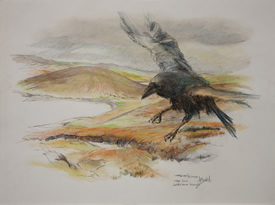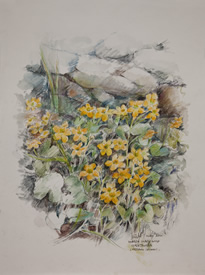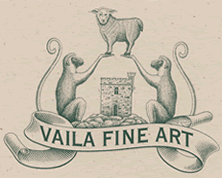Peter Biehl. May to October
Opens 10 June 2011
Pricing
All works available for sale.
May to October by Peter Biehl
The forthcoming exhibition at Vaila Fine Art is of new works by Peter Biehl, a Danish artist living in Tresta.
 Peter Biehl is a member of Veer North and his immediately
recognisable drawings of wildlife will be familiar to the
Shetland public. The drawings are extremely accessible and
pleasing, effortless in appearance and essentially decorative.
However, no “child of five”, so often quoted by
amateur reviewers when presented with contemporary work, could
draw like Peter Biehl. The subjects of the images are all
individual, not generic. They are all painstakingly observed
and competently rendered, rather traditionally presented portraits
of plants, birds, sheep and ponies, captured on a particular
day in their habitat, selected for their personal appeal to
the artist and masterfully executed. It is in fact quite hard
to separate technique from the mixed media of crayons, watercolour
and oil pastel. It takes real effort to see how exactly the
artist managed to convey anatomical complexity with such confident
economy of touch. Peter Biehl applies his craft as lightly
as he carries his chronological advantage: he was born in
Nazi occupied Denmark in 1941.
Peter Biehl is a member of Veer North and his immediately
recognisable drawings of wildlife will be familiar to the
Shetland public. The drawings are extremely accessible and
pleasing, effortless in appearance and essentially decorative.
However, no “child of five”, so often quoted by
amateur reviewers when presented with contemporary work, could
draw like Peter Biehl. The subjects of the images are all
individual, not generic. They are all painstakingly observed
and competently rendered, rather traditionally presented portraits
of plants, birds, sheep and ponies, captured on a particular
day in their habitat, selected for their personal appeal to
the artist and masterfully executed. It is in fact quite hard
to separate technique from the mixed media of crayons, watercolour
and oil pastel. It takes real effort to see how exactly the
artist managed to convey anatomical complexity with such confident
economy of touch. Peter Biehl applies his craft as lightly
as he carries his chronological advantage: he was born in
Nazi occupied Denmark in 1941.
Peter Biehl’s father was Danish and his mother came from the Siberian city of Irkutsk. His maternal grandfather, a high-ranking officer in the Russian White Army, was killed in an ambush during the Revolution. This fact may not be strictly relevant to the current exhibition, but it’s always good to know where adopted Shetlanders originally hail from. Peter trained at the Royal Academy of Fine Art in Copenhagen, funding his studies by working at night as a taxi driver. He then worked as a college art teacher in Denmark, with two memorable years spent at Thule Air Base in far Northern Greenland. The Inuit culture held a lasting fascination, and so did the rugged beauty of Iceland and the Faroe Islands. Peter first discovered Shetland sixteen years ago and finally settled here after his retirement five years ago: “Shetland with its perpetual poetical nonchalance has been an inevitable challenge to my art.” He contributed to the Atlantic Review and Crossing Waater exhibitions.
 Peter works outdoors. He carries his studio equipment with
him and settles down to capture flora and fauna of the place
while being ravaged by the elements but often also rewarded
by the wild creatures gradually accepting his presence on
their territory. Ramna the raven is one such bird. Her family
feature in many paintings. Peter does not accept commissions
to paint other people’s choice of subject, no matter
how beautiful or interesting. His selection of protagonists
comes from within. His paintings are the ultimate respectful
tribute to nature’s fragile diversity. While it is not
too wise to chat about art, Peter’s own words are often
very apt at modestly conveying the spirit of his pictures: “I
am drawn to the rugged coastline, the shift between the mildness
and cruelness of its temperament, seduced by the light, the
contrast, the unfolding drama between life and death. Delicate
wildflowers, tough self-reliant ponies, majestic seabirds
and shy, sly ravens are also significant features of my work”.
Peter works outdoors. He carries his studio equipment with
him and settles down to capture flora and fauna of the place
while being ravaged by the elements but often also rewarded
by the wild creatures gradually accepting his presence on
their territory. Ramna the raven is one such bird. Her family
feature in many paintings. Peter does not accept commissions
to paint other people’s choice of subject, no matter
how beautiful or interesting. His selection of protagonists
comes from within. His paintings are the ultimate respectful
tribute to nature’s fragile diversity. While it is not
too wise to chat about art, Peter’s own words are often
very apt at modestly conveying the spirit of his pictures: “I
am drawn to the rugged coastline, the shift between the mildness
and cruelness of its temperament, seduced by the light, the
contrast, the unfolding drama between life and death. Delicate
wildflowers, tough self-reliant ponies, majestic seabirds
and shy, sly ravens are also significant features of my work”.
All works are for sale and the exhibition continues until late July.
